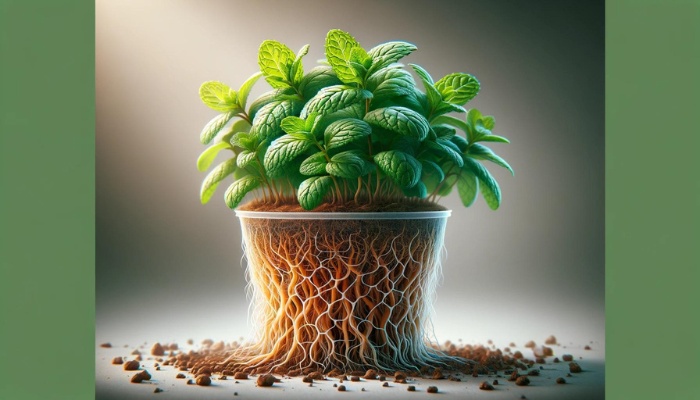Root rot—two words every gardener dreads. In a hydroponic system, sufficient oxygenation and system maintenance typically prevent root rot from developing, but preventative measures are essential.
When signs of root rot appear, knowing how to stop it in its tracks can enable you to save most of your crops if you act quickly.
Discover how to identify early signs and implement a foolproof treatment plan to prevent this nightmare from becoming your reality.
Understanding Root Rot
Root rot, a pervasive issue in hydroponic systems, stems from the overgrowth of fungi or bacteria in waterlogged conditions, compromising plant health by attacking the root system.
This condition primarily arises when the balance between microbial interactions and environmental factors is disrupted. Your understanding of these elements is key for managing and preventing root rot.
Microbial interactions in hydroponic systems are complex. Beneficial microbes compete with pathogens for resources, often controlling the population of harmful organisms.
However, when environmental conditions favor pathogen growth, the balance tips, leading to root rot.
Factors such as inadequate oxygen levels, improper nutrient concentration, and suboptimal water temperatures exacerbate this imbalance.
Environmental factors play a significant role in the development and spread of root rot. High humidity and temperatures, coupled with stagnant water, create ideal conditions for the proliferation of pathogens.
These conditions, in turn, affect oxygen solubility in water, further depriving roots of necessary oxygen and making them susceptible to disease.
Understanding the intricate relationship between microbial interactions and environmental factors is key to diagnosing, preventing, and treating root rot in hydroponic systems.
This knowledge allows you to adjust your system’s conditions to favor beneficial microbes, thereby safeguarding plant health.
If you suspect root rot might be an issue, look for brown or black roots, mushy roots, poor plant health, and a foul odor
Common Causes
Understanding the intricate dynamics of microbial interactions and environmental factors sets the stage for identifying the common causes behind root rot in hydroponic systems.
Primarily, the imbalance between beneficial and harmful microorganisms is a critical factor. When harmful pathogens outnumber the beneficial ones, root rot can rapidly take hold.
Observing root colors provides a clear indication of health; healthy roots typically exhibit a white or cream color, while brown or black roots signal decay and disease.
Another pivotal aspect is the ambient temperature surrounding your hydroponic setup. Pathogens thrive in warm conditions, specifically in temperatures ranging from 68°F to 86°F (20°C to 30°C).
These temperatures accelerate the growth of fungi such as Pythium and Phytophthora, notorious for causing root rot.
Poor water quality, characterized by high levels of organic matter and insufficient oxygenation, creates an environment conducive for these pathogens to flourish.
Ensuring a sterile environment and closely monitoring the system’s water temperature are fundamental in mitigating the risk of root rot.
Prevention Strategies
To effectively prevent root rot in hydroponic systems, you must implement a comprehensive water management strategy that ensures optimal oxygen levels and minimizes pathogen proliferation.
One key aspect of this is maintaining an appropriate water temperature. Research indicates that water temperatures between 64°F and 72°F (18°C-22°C) are ideal for most hydroponic systems.
Temperatures outside this range can stress plants, making them more susceptible to root rot pathogens. To consistently maintain this range, you’ll want to invest in a reliable water temperature control system.
Additionally, managing nutrient concentration meticulously is essential.
An imbalance in nutrient levels can either deprive your plants of essential minerals or cause nutrient toxicity, both of which can weaken your plants and make them more vulnerable to infections.
Utilize a high-quality water testing kit to monitor nutrient levels regularly, adjusting as necessary to maintain the optimal concentration.
Effective Treatment Methods
Once you’ve identified root rot in your hydroponic system, immediate action is required to mitigate the damage and salvage your plants. Here are four effective treatment methods grounded in research:
- Remove Affected Roots: Carefully trim away the infected parts of the root using sterilized scissors. This prevents the spread of pathogens and encourages healthy regrowth.
- Increase Oxygenation: Enhance the oxygen levels in your nutrient solution. Pathogens thriving in anaerobic conditions are less likely to survive in well-oxygenated environments.
- Chemical Alternatives: Utilize hydrogen peroxide or other approved chemical treatments specifically designed for hydroponic systems. These agents can effectively kill pathogenic organisms without harming your plants when used correctly.
- Biological Control: Introduce beneficial microbes that outcompete or directly antagonize root rot pathogens. Products containing strains of Bacillus, Trichoderma, or mycorrhizal fungi have shown promise in suppressing root rot while promoting plant health.
Each of these methods requires careful implementation and monitoring. Adjust your approach based on the specific needs of your plants and the extent of the root rot infestation.
Maintaining a Healthy System
Preventing root rot in your hydroponic system starts with rigorous maintenance and monitoring practices to ensure optimal plant health. A critical aspect of this prevention strategy is the meticulous control of water temperature.
Research indicates that maintaining water temperatures between 64°F and 72°F (18°C-22°C) significantly reduces the risk of root rot pathogens thriving.
This temperature range discourages the proliferation of fungi such as Pythium and Fusarium, notorious for causing root rot.
Equally important is the precise management of nutrient balance within your hydroponic system. An imbalance, whether it’s an excess or deficiency, can stress plants, making them more susceptible to diseases including root rot.
To maintain this balance, you’ll need to regularly test your nutrient solution’s EC (electrical conductivity) and pH levels, adjusting them as required to ensure they remain within optimal ranges for your specific plants.
This involves not only adding nutrients but also diluting the solution or adjusting its pH when necessary.
Adhering to these guidelines ensures your hydroponic system fosters a robust environment where plants can thrive, free from the debilitating effects of root rot.

